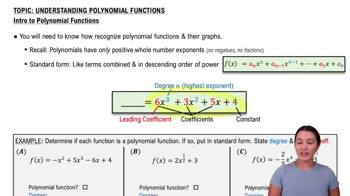Table of contents
- 0. Functions7h 52m
- Introduction to Functions16m
- Piecewise Functions10m
- Properties of Functions9m
- Common Functions1h 8m
- Transformations5m
- Combining Functions27m
- Exponent rules32m
- Exponential Functions28m
- Logarithmic Functions24m
- Properties of Logarithms34m
- Exponential & Logarithmic Equations35m
- Introduction to Trigonometric Functions38m
- Graphs of Trigonometric Functions44m
- Trigonometric Identities47m
- Inverse Trigonometric Functions48m
- 1. Limits and Continuity2h 2m
- 2. Intro to Derivatives1h 33m
- 3. Techniques of Differentiation3h 18m
- 4. Applications of Derivatives2h 38m
- 5. Graphical Applications of Derivatives6h 2m
- 6. Derivatives of Inverse, Exponential, & Logarithmic Functions2h 37m
- 7. Antiderivatives & Indefinite Integrals1h 26m
- 8. Definite Integrals4h 44m
- 9. Graphical Applications of Integrals2h 27m
- 10. Physics Applications of Integrals 2h 22m
2. Intro to Derivatives
Derivatives as Functions
Problem 3.2.31a
Textbook Question
31–32. Velocity functions A projectile is fired vertically upward into the air, and its position (in feet) above the ground after t seconds is given by the function s(t).
a. For the following functions s(t), find the instantaneous velocity function v(t). (Recall that the velocity function v is the derivative of the position function s.)
s(t)= −16t²+100t
 Verified step by step guidance
Verified step by step guidance1
Step 1: Identify the position function s(t) given in the problem, which is s(t) = -16t^2 + 100t.
Step 2: Recall that the instantaneous velocity function v(t) is the derivative of the position function s(t) with respect to time t.
Step 3: Differentiate the position function s(t) = -16t^2 + 100t with respect to t. Use the power rule for differentiation, which states that the derivative of t^n is n*t^(n-1).
Step 4: Apply the power rule to each term in s(t). The derivative of -16t^2 is -32t, and the derivative of 100t is 100.
Step 5: Combine the derivatives to find the velocity function v(t). Therefore, v(t) = -32t + 100.
 Verified video answer for a similar problem:
Verified video answer for a similar problem:This video solution was recommended by our tutors as helpful for the problem above
Video duration:
2mPlay a video:
Was this helpful?
Key Concepts
Here are the essential concepts you must grasp in order to answer the question correctly.
Derivative
The derivative of a function measures how the function's output changes as its input changes. In the context of motion, the derivative of the position function s(t) gives the instantaneous velocity v(t). This concept is fundamental in calculus as it provides a way to analyze rates of change.
Recommended video:

Derivatives
Instantaneous Velocity
Instantaneous velocity refers to the velocity of an object at a specific moment in time. It is calculated as the derivative of the position function with respect to time. For the given position function s(t), finding v(t) involves applying differentiation to determine how fast the projectile is moving at any time t.
Recommended video:

Derivatives Applied To Velocity
Quadratic Functions
A quadratic function is a polynomial function of degree two, typically expressed in the form s(t) = at² + bt + c. In this case, the position function s(t) = -16t² + 100t is a quadratic function, where the coefficients determine the shape of the parabola. Understanding the properties of quadratic functions is essential for analyzing projectile motion.
Recommended video:

Introduction to Polynomial Functions
Related Videos
Related Practice



